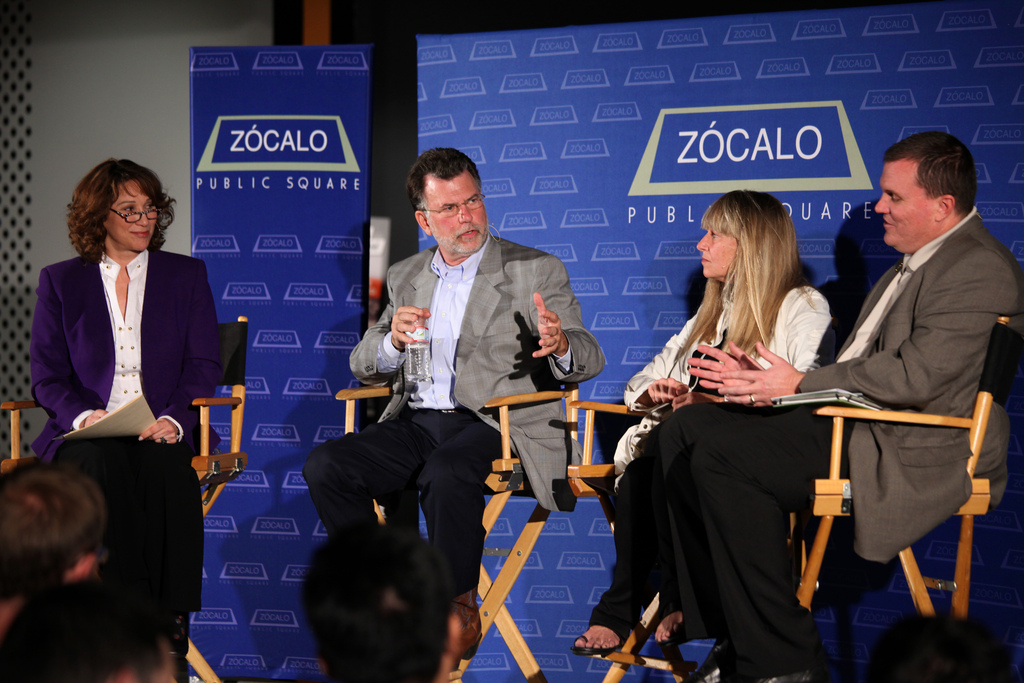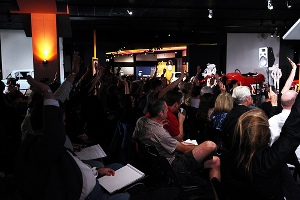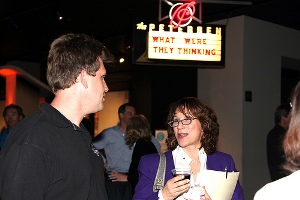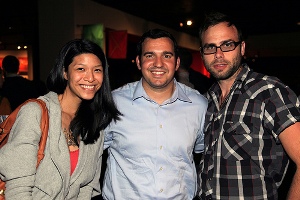
At the Petersen Automotive Museum, sitting next to a sign that read “What were they thinking?” in a roomful of cars that flopped, Val Zavala thought it a fitting place to talk high-speed rail. “What were they thinking,” she said, “is what a lot of people are thinking when they hear what a high-speed rail project would cost.”
That cost rings up to $42 billion, said Zavala, host of KCET SoCal Connected, a co-sponsor of the event. Zavala joined L.A. County Metropolitan Transit Authority Board Member Richard Katz, Gloria Ohland of Reconnecting America and Adrian Moore of the Reason Foundation to see just how sound an investment high-speed rail – and public transit in general – is for California.
Tens of billions for a choo-choo
 High-speed rail is a much-touted technology, but a costly and potentially problematic one to implement. A proposed California system, Zavala noted, “hasn’t even broken ground and we’re already worried about its feasibility.” Katz, who sits on the state’s High Speed Rail Authority, argued that the audit may have been accurate a year ago – when it was conducted – but not anymore. A successful November 2008 bond measure supporting rail, plus increased federal support, means funds are more secure than imagined and interest is high. Katz acknowledged that the audit did raise some good questions about oversight of tax dollars and public outreach. Regarding the Authority, “You have to change the organization to a group that knows how to build a $42 billion choo-choo,” he said. “It’s a much different task.”
High-speed rail is a much-touted technology, but a costly and potentially problematic one to implement. A proposed California system, Zavala noted, “hasn’t even broken ground and we’re already worried about its feasibility.” Katz, who sits on the state’s High Speed Rail Authority, argued that the audit may have been accurate a year ago – when it was conducted – but not anymore. A successful November 2008 bond measure supporting rail, plus increased federal support, means funds are more secure than imagined and interest is high. Katz acknowledged that the audit did raise some good questions about oversight of tax dollars and public outreach. Regarding the Authority, “You have to change the organization to a group that knows how to build a $42 billion choo-choo,” he said. “It’s a much different task.”
You aren’t my density
Moore cited a more fundamental problem: a rail system that has too-high expectations of speed and ridership. “Not that many people go between San Francisco and Los Angeles,” he said. And local government funding isn’t likely to be forthcoming in a dire economy. “Did anybody notice L.A.’s broke?”
But Ohland argued for the line based on another fundamental, reducing American dependence on foreign oil, as the high-speed rail is electric-powered. She added that transit systems need redundancy even though “that sounds like a bad word” – to handle disasters and security crises.
Pretzel-less
Zavala asked if a train is really better than a plane between northern and southern California, or a car for shorter commutes. Moore doubted it. “We travel by cheap airlines and we drive,” he said. “The train has to be a fantastically better deal to get people to ride it.” He added that even in Europe and Asia, where inner-city travel has always been done by rail, car ownership is on the rise and public transit is losing market share. In the U.S., even though cars were slower and more expensive than train travel for decades, Americans adapted quickly to the car. (As Zavala found from a quick poll of the audience, though, about half had used public transit in the last week, and a third used it to come to the event. Two panelists had used transit in the last week, but none took it to the event.)
 Ohland thought that the inconveniences of air travel make train travel a good option despite, she joked, the airplanes’ “fabulous pretzels.” And as Katz noted, Californians won’t be looking for it to beat air, necessarily, but just to do better than their cars. Between Anaheim and Los Angeles, he said, “go 70 or 80 miles per hour and everyone will think they’ve died and gone to heaven.”
Ohland thought that the inconveniences of air travel make train travel a good option despite, she joked, the airplanes’ “fabulous pretzels.” And as Katz noted, Californians won’t be looking for it to beat air, necessarily, but just to do better than their cars. Between Anaheim and Los Angeles, he said, “go 70 or 80 miles per hour and everyone will think they’ve died and gone to heaven.”
30/10
L.A. County has some ambitious transportation plans of its own – to fund 12 projects slated to be completed in 30 years in a mere 10 years. The funding, Zavala noted, would come from an up-front government loan – still to be negotiated – that the County would pay back over 30 years, using funds from the already-passed Measure R. The 30/10 plan, Katz argued, acknowledges that L.A. needs a multi-part approach to transportation, working simultaneously on, the Expo Line, the Gold Line extension, a route from Van Nuys to Westwood either underground or light rail, and so on. Building at once, he said, would save costs (the county could get lower construction bids and go to “the Costco for rail construction”). It would also improve public health by reducing pollution and encouraging walking, and pull the city out of its dire economic straits.
It’s a good deal for L.A., Moore acknowledged, but less so for the country, which would subsidize the project. But, Ohland argued, cars are also a heavier cost than we may think. From insurance to repairs to payments, car costs are disaggregated – making it hard to keep track of then. In the time of streetcars, she said, transportation cost three percent of the household budget – now it costs on average 20 percent, the second highest expense after housing. Finally, she said, healthcare costs would go down not only because of reduced levels of asthma but also because transit riders get more exercise.
Good old-fashioned buses
 But rail projects may not be the best option for L.A. transit, Moore argued, given that the vast majority of Angelenos use cars. “You can’t spend 50 percent of the money on two percent of the people,” he said, noting that underfunded roads will severely inhibit mobility in the city. Ohland also acknowledged that “we cannot serve this sprawling landscape with public transportation.” And even if it were possible, Moore argued, “the freedom and the mobility of the automobile are much better.”
But rail projects may not be the best option for L.A. transit, Moore argued, given that the vast majority of Angelenos use cars. “You can’t spend 50 percent of the money on two percent of the people,” he said, noting that underfunded roads will severely inhibit mobility in the city. Ohland also acknowledged that “we cannot serve this sprawling landscape with public transportation.” And even if it were possible, Moore argued, “the freedom and the mobility of the automobile are much better.”
Electric and hybrid cars are a better answer to pollution and oil concerns, Moore argued. But as Katz noted, electric vehicles still derive energy from coal plants, meaning they’re “just polluting in someone else’s backyard.” Congestion pricing, like toll roads, could help reflect the true costs of travel, Moore and Zavala noted, but as Katz said, L.A. is too sprawling for that.
During Q&A, however, the panelists found they all agreed on one thing: bus rapid transit. Katz noted that the Valley’s Orange Line had been highly successful. Many, he said, “figure they need the shiniest, newest thing on the block” when a bus line would do. Ohland noted that it has a big following in New York. But Moore was still a bit pessimistic.
“We all agree,” he said. “And yet we can’t do it in L.A. because of the system we have for making these decisions.”
Watch the video here.
Watch a highlight clip here.
See more photos here.
Read In The Green Room Q&As with the panelists: Val Zavala, Richard Katz, Gloria Ohland, Adrian Moore
*Photos by Aaron Salcido.




Send A Letter To the Editors